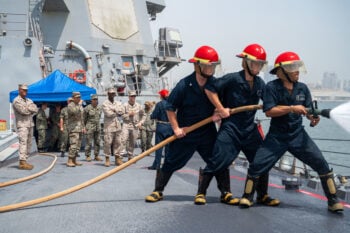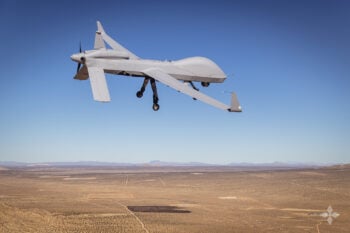
A Beriev A-50 takes part in rehearsal for 2020 Victory Day parade, in Moscow’s Tverskaya Street, Russia on June 20, 2020. (Sefa Karacan/Anadolu Agency via Getty Images)
WARSAW — UK MoD Defence Intelligence reported Nov. 17 that Russia’s Aerospace Forces (VKS) are increasingly risking their most advanced Airborne Early Warning (AEW) aircraft, the Beriev A-50U, to identify enemy airborne targets in Ukraine airspace.
The A-50U (NATO Codename MAINSTAY-D) features a 30-foot diameter rotating radar dome similar to the well-known US Boeing EA-3 Sentry AWACS. Accordingly, it can detect and identify enemy aircraft at longer ranges than the radar sets of Russian fighters or SAM systems, “because its altitude allows it to see further around the curvature of the earth,” reads the report from MoD in London.
The heart of the A-50U upgrade replaces previous-generation analogue electronics with a modern, digital avionics suite that speeds data processing and enhances both signal tracking and target detection. Spokesmen for the RosElectronica consortium that produces the on-board hardware state the A-50U configuration can detect more types of aircraft and simultaneously track a larger number of targets and guided missiles than the previous-generation variant.
Since the start of the Ukraine war, the A-50U has been largely utilized for battle management of VKS fighter aircraft, as well as providing long range, ground targeting coordinates for Mikoyan MiG-31K aircraft carrying the Kh-47M2 Kinzhal hypersonic missile.
While over 40 A-50s have been produced, there are only eight of this most advanced version of the aircraft, and any lost in action would be difficult if not impossible to replace. Russia has deployed the planes accordingly, keeping the aircraft well back from Ukrainian air defense systems. Fear of losses was exacerbated following a drone attack on one aircraft in February while it was parked at an aerodrome in Belarus.
That Russia would be willing to move the planes forward is a tacit acknowledgement of the ongoing issues with the VKS, but there are three specific reasons for the move now: Russian air losses, the need to maximize the S-400 air defense system, and preparing for an influx of Western-made fighter jets in 2024.
RELATED: Why drones targeted a Russian A-50U, vital for hypersonic Kinzhal strikes
As Ukraine’s air defenses improve and with the coming of western fighter models, the VKS will be forced to make some difficult choices, said a Ukrainian defense electronics and EW expert who spoke to Breaking Defense. “They will have to decide what costs them more: to lose one or more of these A-50s or to continue to see their combat aircraft and S-400 units progressively degraded.”
Major Russian Air Losses, With No Replacements
This first point is the extensive VKS losses since hostilities began. Tabulations vary, but a detailed assessment from RAND expert Michael Bohnert calculates as few as 84 and up to as many as 130 fixed- and rotary-wing aircraft have been lost by Russia. That includes losses due to Ukrainian air-to-air kills, shoot downs by Ukraine’s air defense units and crashes due to training or other accidents.
Bohnert also calculates “imputed” losses of between 27 to 57 aircraft, due to the VKS flying aircraft for a far greater number of hours and at op-tempo far above the normal wear-and-tear that Russian platforms are designed to endure. (In his analysis, Bohnert also notes imputed losses are likely higher.)
These losses are forcing the VKS to conduct operations further back from the front lines, trying to keep aircraft out of harms way, in contrast to the strategy deployed at the start of the conflict. This change in tactics was called out by US Air Forces Europe/Africa head Gen. James B. Hecker in September.
RELATED: Russia’s Air Force ‘eating into’ aircraft lifespans, with no easy solution
“When it [the VKS] first started out, they were flying right into the surface-to-air missile engagement zones of the Ukrainians,” he said in an interview with Air & Space Forces Magazine. “So, they now don’t fly in those rings, or if they do, it is for low altitude for very quick moments and then they go back out. That’s adapting for saving aircraft, but obviously it doesn’t bode well for dropping bombs and trying to gain air superiority,” Hecker stated.
A Nov. 28 Newsweek report cited a Ukrainian spokesperson saying that “after the [Russian] loss of eight Sukhoi Su-25 subsonic [close air support] attack aircraft near Avdiivka, the use of front-line aircraft and attack helicopters was significantly reduced.” The spokesperson said the VKS have been using Su-35s, the most advanced fighter aircraft in the Ukraine theatre, to drop guided aerial bombs.
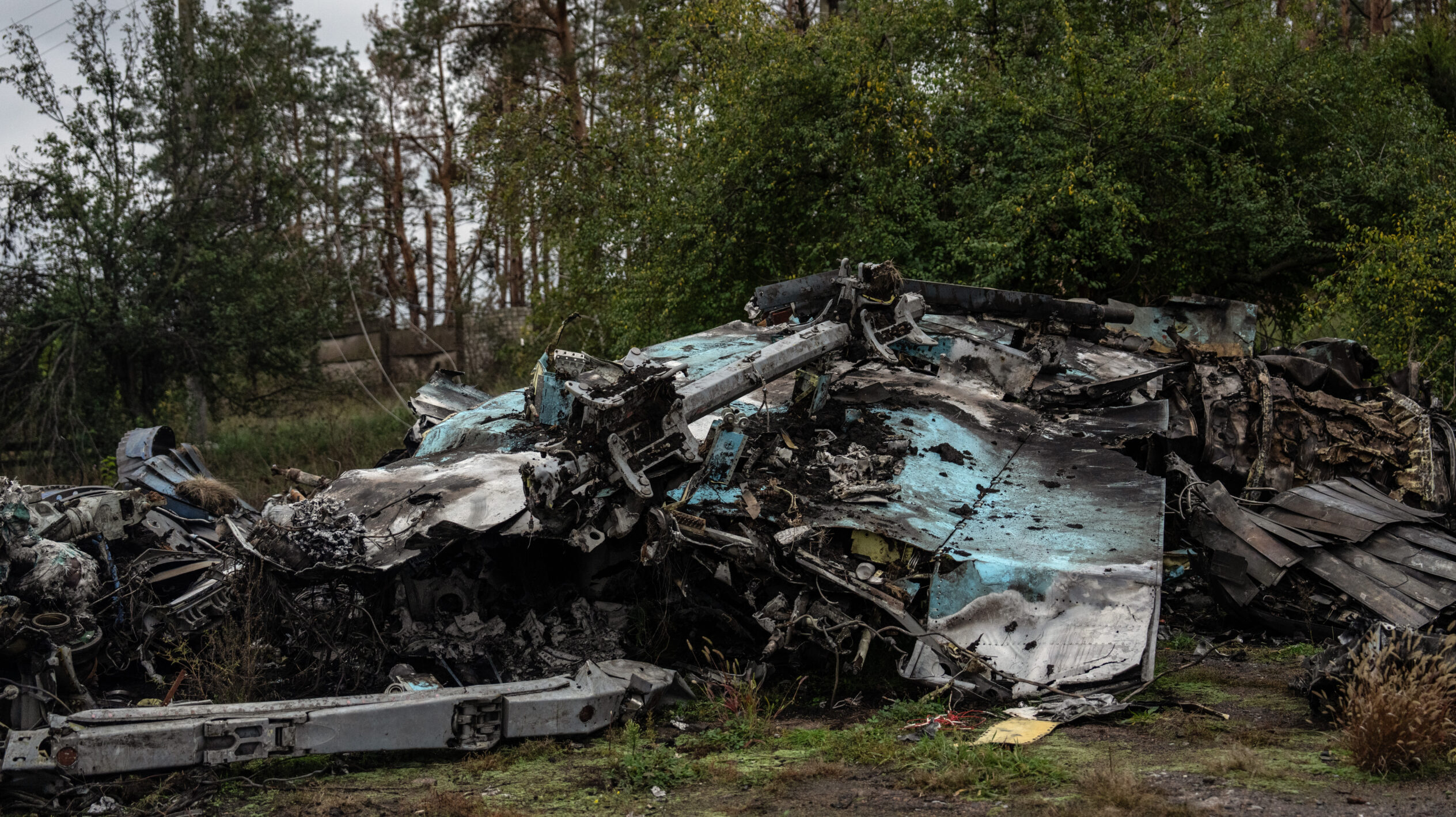
The remains of a Russian Sukhoi Su-34 supersonic fighter bomber that was downed during fighting to recapture the strategic eastern town of Lyman are pictured on October 11, 2022 in Lyman, Donetsk oblast, Ukraine. (Photo by Carl Court/Getty Images)
The practice of the VKS has been a pattern of “back and forth” in its deployments, said Justin Bronk from the Royal United Service Institute (RUSI), who spoke with Breaking Defense at the October Warsaw Security Forum.
“The Russian Air Force tend to take a beating and then pull back well out of range. Then – one step at a time – they inch back towards the front lines, until they suffer another ‘bloody nose’ incident of some nature. They then pull back to safe distance again until such time as they decide to once again slowly move towards the forward edge of the battle area (FEBA),” he explained.
Consistent with past practice, the VKS are in one of their withdrawing to the rear moments, so the Su-35s “operate from a distance,” remaining out of range of Ukraine’s air defenses. This according to Col. Oleksandr Shtupun, the spokesman for Ukraine armed forces Tavria group of forces. “Over the past two days, more than 20 such [Su-35] airstrikes have been recorded.”
Despite all that, it seems the A-50U is breaking the mold and actually creeping closer to the front lines, rather than behind it. Increasing use of the A-50U could further minimize losses by not only locating and tracking Ukrainian aircraft, but also steering VKS formations to avoid them. It is also being employed to identify and mark specific areas that are defended by Ukraine’s growing network of surface-to-air missile batteries.
Dependent Targeting For S-400
A second role the A-50U has been pressed into is sharing the air data picture data from its SATCOM radar via datalink to Moscow’s most modern air defense system, the Almaz-Antei S-400 (SA-21). This creates a more integrated air defense network effective at greater ranges.
Employed for this mission, the VKS can maximize the effectiveness of their S-400s by also utilising the A-50U’s radar to extend the target engagement envelope. In a lengthy report from the Russian TASS news agency, one of the senior experts from Russia’s air defense forces (PVO) explained how this dependent targeting is accomplished.
One approach, the expert told TASS, is to set the active-homing seeker heads of the S-400’s missiles into a lock-on after launch mode. This makes the missile dependent on a mid-course correction radar datafeed to the missile before the seeker goes active and enters terminal phase. But in this case, the mid-course data is instead transmitted by the A-50U’s on-board radar system instead of the S-400’s command post.
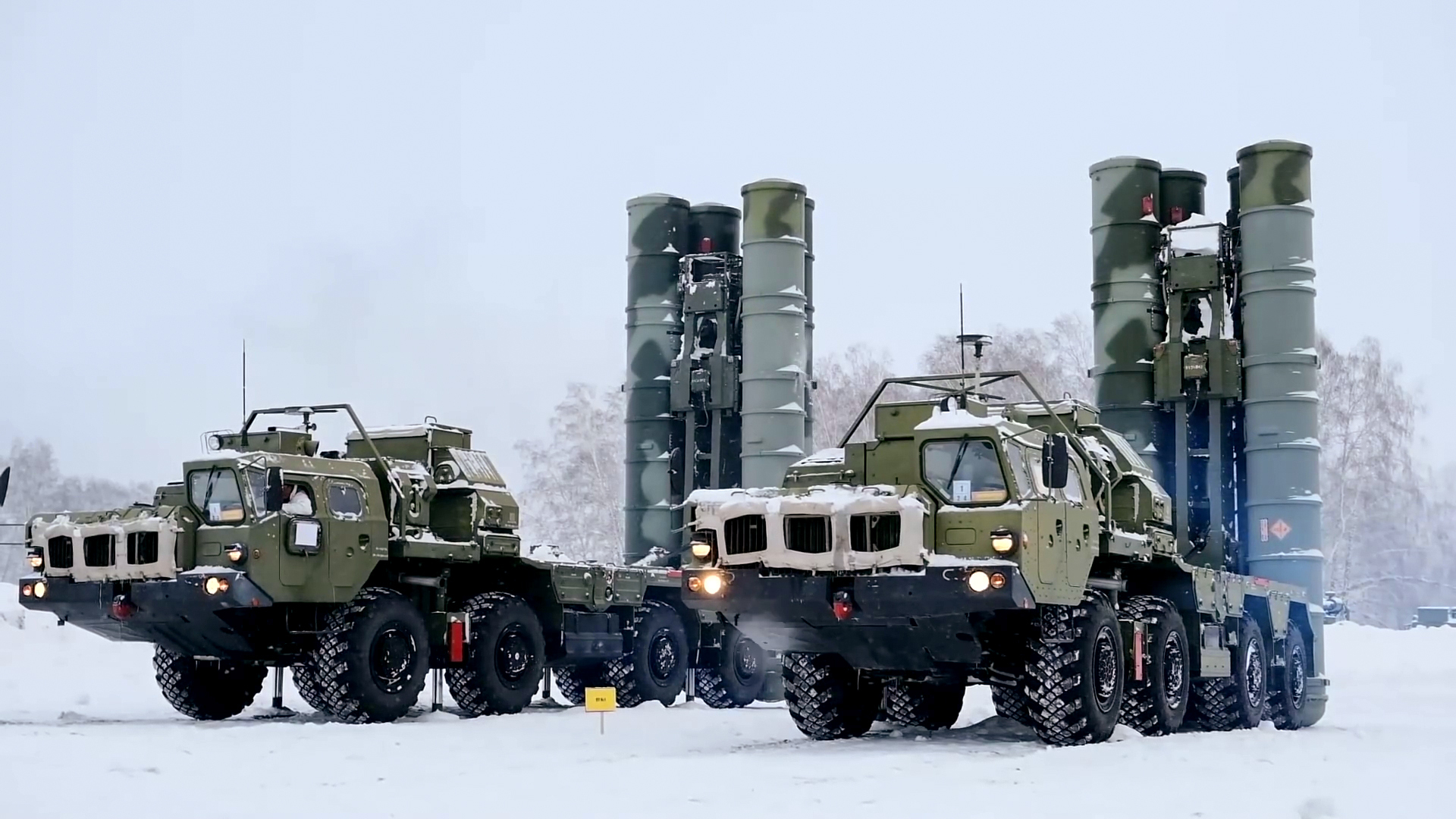
S-400 defense systems, sent by Russia, are seen at the Brestsky training ground ahead of the Allied Resolve – 2022 joint military exercise near Brest, Belarus, on February 03, 2022. (Photo by Russian Defense Ministry / Handout/Anadolu Agency via Getty Images)
Another method discussed is for the A-50U air crews and the S-400 command centers to share data and load target information to the missile’s guidance system prior to launch. This still requires a datalink to the seeker from both the S-400 and A-50U radar sets. In this scenario the S-400 can mask its radar signal by operating in a training setting so that it will not trip an enemy aircraft’s radar warning receiver. Again, the A-50U provides the mid-course correction data.
Notably, the Russian expert did not spell out how many targets can be tracked and fired on in this manner or what the range boost the A-50U gives the S-400 — keeping details that could aid in countering this joint system out of the public. Notably, the S-400 equipped with the kind of active-homing seeker needed for this pairing to work was only deployed to Ukraine in early November, which may be a signal of challenges in building up an active seeker arsenal.
Fear Of Western Fighters
The third rationale for increased use of the A-50U, according to MoD Intelligence reports, are concerns about the pending introduction of western fighter aircraft into Ukrainian Air Force (PSU) service. Not only would Ukraine receiving the US F-16 and/or the Swedish Saab JAS-39 Gripen constitute the threat of more VKS aircraft losses, but any S-400s being deployed to neutralize those western aircraft would be increasingly vulnerable to attacks from the air.
The number of S-400s lost to air and missile attacks has, in some ways, become a more serious problem for the Russian military than the number of aircraft shot down. Several batteries have been destroyed by Ukrainian drone and missile attacks, including two in Crimea in late August, September and another unit again in late October.
The S-400 units in Crimea were taken out by a new, land-attack variant of the same Ukraine-designed DKB Luch Neptune anti-ship missile that was used to sink the Moskva guided missile cruiser in April 2022. That earlier anti-ship version of the missile had a 190-mile range and carried a 330-pound warhead. The new model used against the S-400 has a 225-mile range and is fitted with a 770-pound warhead.
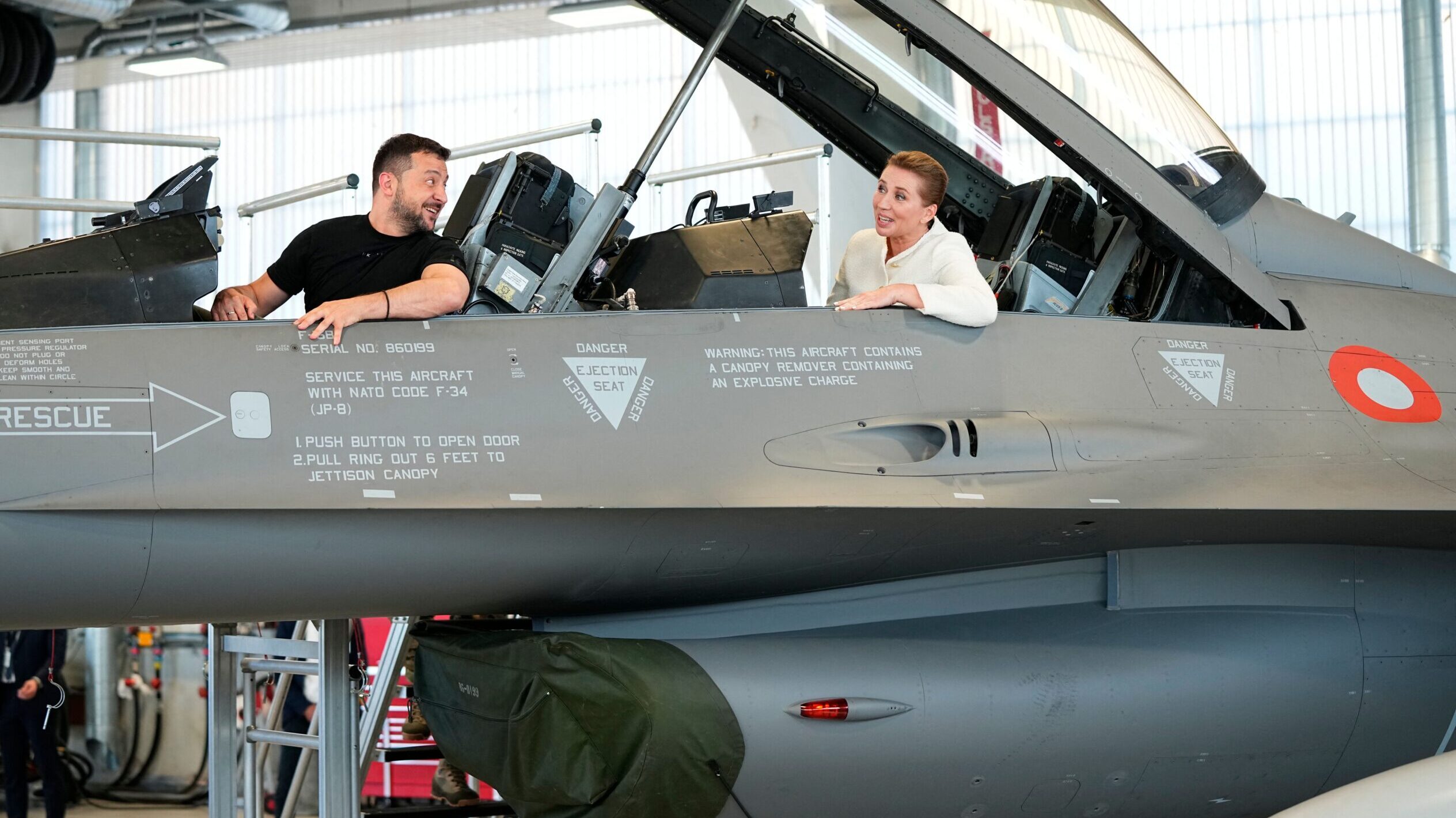
Ukrainian President Volodymyr Zelensky (L) and Danish Prime Minister Mette Frederiksen (R) react as they sit in a F-16 fighter jet in the hangar of the Skrydstrup Airbase in Vojens, northern Denmark, on August 20, 2023. Washington has told Denmark and the Netherlands that they will be permitted to hand over their F-16 fighter jets to Ukraine when the country’s pilots are trained to operate them, the US State Department said on August 18, 2023. Both Denmark and the Netherlands are leading the program to train Ukraine’s pilots on the F-16. (Photo by Mads Claus Rasmussen / Ritzau Scanpix / AFP) / Denmark OUT (Photo by MADS CLAUS RASMUSSEN/Ritzau Scanpix/AFP via Getty Images)
Units lost in combat to date cannot be replaced with new production anytime soon due to shortages of modern, electronic components, and Moscow now seemingly has fewer S-400s than it needs to protect its airbases, command centers and what is left of the Black Sea Fleet. The evidence? Russia’s forces have now resorted to re-deploying batteries that had been based in the western enclave of Kaliningrad. The movement of these S-400s down to Ukraine took place by what the MoD intelligence document describes as “exceptional Russian air transport movements in November” that were observed by NATO satellite and ISR platforms.
A Nov. 26 MoD Defence Intelligence report concludes shrinking the number of S-400s is no small matter. It means Moscow is willing to “accept additional risk” around Kaliningrad, a strategically important region of Russia, by stripping part of its air defenses and transporting them to the Ukraine theatre.
This choosing a lesser of two evils “highlights the overstretch the war has caused for some of Russia’s key, modern capabilities,” reads the intelligence report. By destroying the S-400s, the Ukrainians have significantly degraded the air defense net, as the utility of medium- and short-range SAM batteries that normally operate in tandem with it become minimized.
TAI exec claims 20 Turkish KAAN fighters to be delivered in 2028
Temel Kotil, TAI’s general manager, claimed that the domestically-produced Turkish jet will outperform the F-35 Joint Strike Fighter.
















